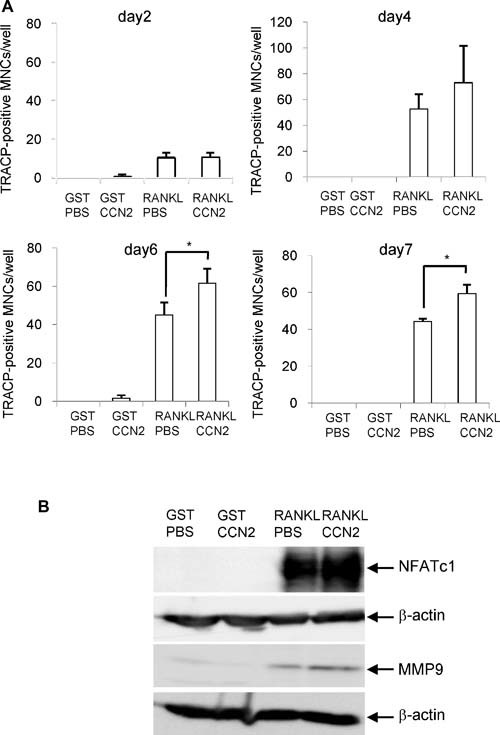Figure 2.

(A) Effect of CCN2 on osteoclast formation induced by GST‐RANKL. CCN2 increased TRACP+ multinucleated cell (MNC) formation from RAW264.7 cells. Cells were inoculated at a density of 1 × 104/cm2 in 12‐well multiwell plates, and the next day they were stimulated by GST‐RANKL or GST in the presence or absence of rCCN2 (50 ng/mL). After 3 days of treatment with these factors, the cells were refreshed with fresh α‐MEM containing 10% serum with these factors and cultured for 7 days. Differentiated RAW264.7 cells were defined and quantified as TRACP+ multinucleated cells (MNCs) on days 2, 4, 6, and 7. Data are the means ± SD of triplicate cultures. The asterisk indicates a significant difference from the sample RANKL/PBS (p < .05). (B) Effect of CCN2 on the production of NFATc1 and MMP‐9, which are osteoclast differentiation markers. RAW264.7 cells were treated with GST‐RANKL or GST in the presence or absence of rCCN2 for 6 days or 8 days. Then, cell lysate was collected and Western blot analysis was performed by using anti‐NFATc1 or anti‐MMP9 antibody. The amount of NFATc1 was increased in the cells treated with combination of CCN2 and GST‐RANKL, compared with that with GST‐RANKL alone for 6 days (upper panel). β‐Actin was used as an internal control (lower panel). Similarly, the amount of MMP‐9 also was increased in the cells treated with combination of CCN2 and GST‐RANKL for 8 days.
